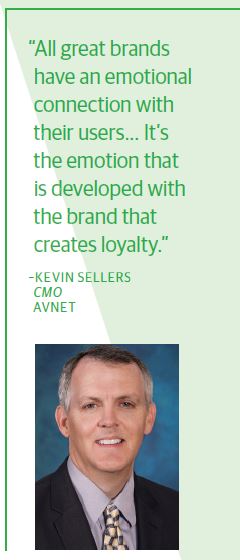Bringing Emotion to a B2B Brand
Avnet CMO Kevin Sellers helps unify the brand around emotional connections with customers.

Avnet’s Chief Marketing Officer Kevin Sellers captured the attention of a packed crowd at the recent Leadscon conference as he harkened back to the 1947 jewelry campaign, “A Diamond is Forever,” coined by De Beers’ Mary Gerety.
The simple but catchy phrase reinvented what symbolized love with a simple emotional concept, Sellers explained, adding that the best brands own a simple message that breaks through the clutter.
When he joined Avnet, an electronics distributor, in 2015, he said it was “the biggest electronics company no one knew.” This led to an immersive rebranding experience that aimed to bring emotion to his clients’ time with their products. From painting a fresh coat of green as Avnet’s logo to identifying employees as guides to a better client future, Sellers is paving the way for a new customer journey, even in the B2B space.
Customer Strategist: Why is the customer experience important to the success of Avnet?
Kevin Sellers: If the customer is not at the center of all your marketing activity and strategy, then something is very wrong. We exist to develop and delight customers, and businesses that consistently do that are going to be quite successful. We live in a very competitive, very noisy world and customers have choices like they never have before. So we must excel at providing a unique and valuable service for our customers or they will go elsewhere. With the rise of digital tools and capabilities, the ability for customers to switch has never been easier or more affordable. Gone are the days of the high switching costs and we realize that. Given that at the heart of what we do is service, we must be outstanding at that every day.

CS: Can you explain the rebranding process you took with Avnet?
KS: It was a very long process, but it begins with understanding what is true about your company. Great branding is more a reflection of the soul of the company than a phrase or logo. So to get to something that is really powerful you have to know two things: First, what is true about your company? What makes it tick? How is it unique? You first need to find out these things. At Avnet we deployed global research [with customers, suppliers, and employees] to learn more details of what is true about us.
Next, you need to understand what do our customers want/need from us [or a partner like us] in order to be successful. The customer base is constantly evolving, but there tend to be some relatively constant things that they are looking for in a partner that you need to really understand deeply.
Once you know these two things, you can look for the intersection of those to find the magic. Our new brand platform was born out of that intersection directly.
We knew we had something that would work because it was both authentic and true, but also based on what customers wanted. Getting to that intersection is critical for brand success.
CS: How does the new brand look and feel different from the old brand? What are major new brand attributes, and what do they represent?
KS: The importance of a logo cannot be overstated…it communicates each and every time someone looks at or comes across it. When we went about our re-brand, we were very careful to understand what our customers and potential customers thought about our look and feel, and then wanted to ensure that any new representation of the company was communicating the right message.
What we learned about it through research was that [the previous logo] was viewed as “old” or “not modern” too frequently. For a technology company, that is not a good place to be.
When we did our re-brand, we learned a lot of how our customers viewed us—collaborative, service-oriented with lots of ingenuity. So, when putting our logo design together we used color and design to communicate that the best we could. For example, color communicates and carries meaning. The old logo has lots of red—and red, while a dynamic and vibrant color, also carries the meaning of “stop,” “danger,” and “power.” Green, however, communicates meaning such as “collaboration or partnership” and “harmony.” Since our business model is built on trust and service, it fits much more naturally.
The second part of the logo is what we call the “A-frame,” which is constructed to show one side [the suppliers of technology] with the other side [the customers] and the green dash in the middle [Avnet]bringing those two together…It has become quite powerful and consistent and helps us to communicate our role in a unique, memorable, and consistent way.
CS: How did customers help reshape the brand?
KS: They were at the heart of this entire process. They helped us understand the values we were living. It’s one thing to claim certain values, but it’s another to be told by our customers what values we actually demonstrate day-to-day. Having that knowledge provided comfort about our direction given the validation of the research.
CS: Since rebranding Avnet, how have your approach to and interactions with customers changed?
KS: Yes, that transformation is ongoing. But we are much more purpose driven and consistent in how we approach the customer experience overall and that’s a very good thing. We are building a repeatable journey that gives our customers the kind of comfort and predictability that they are looking for.
CS: You mentioned building an emotional connection with customers in Leadscon. What do you do to develop an emotional connection with customers?
KS: All great brands have an emotional connection with their users. That emotion can be quality, reliability, best service, cool factor, edginess, state-of-the-art products, you name it. It’s the emotion that is developed with the brand that creates loyalty and stickiness with customers. So if we only talk about the rational aspects of our company, our products, the features we offer then customers too often end up focusing on price as the determining factor in a purchase.
I often describe Avnet as a company that might not win an Academy Award, but we are the company that the Academy Award winner mentions in their acceptance speech. Our product is service, and so the emotion that is most often associated with Avnet is one of collaboration and trust. Our customers rely on us and really value the relationship aspect of our engagement.
CS: You’ve said that your goal is for Avnet employees to be like the Sherpas who guide companies toward the spotlight. What do you mean by that?
KS: It’s changing as the nature of our customer base is changing. Our approach is to offer an unparalleled omnichannel experience. We already offer great offline capability, but we are now aggressively investing in ensuring our online experience is strong as well. Some newer customers want the flexibility of working 24/7 and to have access not only to products but to services and tools that don’t always require a live body. By focusing on providing the best omnichannel experience we make the customer journey one they get to define, which is ultimately what they want anyway.
CS: What is the biggest challenge you face in creating and maintaining strong customer relationships?
KS: For us, we came from a model of highly decentralized operations to more centralized. That’s not to say that decentralized business models can’t or don’t work—they do. But for us, it was causing terrible brand confusion as our experience was not consistent, our brand was not consistent, the promise we made to the customer was not consistent. This has all changed and we are much better about how we communicate, what we communicate and, most importantly, the overall experience we seek to deliver to the customer.
CS: In 2015 we wrote about Avnet’s “Journey to Customer Centricity” in our sister publication, 1to1 Media. How do you feel the company has evolved in the two years since?
KS: We clearly listen more—and better. We take customer inputs and put action plans for improvement in place across the board to ensure the best customer experience we can possibly have. We take twice annual surveys of Net Promoter Score [NPS] scores, but also turn that into real change. A few years ago, we didn’t really pay as much attention to that feedback because things were fine and as long as we had our supplier relationships in good place, the customer would just “come”—kind of the “Field of Dreams” approach. But that has clearly changed. If you want a brand to resonate, it not only has to be authentic, but it also has to be something you can deliver.





